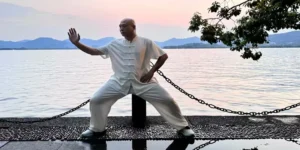Tai Chi practitioners, especially those who are new, often encounter nagging injuries, like knee pain, lower back strain, shoulder impingement, or hamstring pulls. Frequently, the root cause isn’t the Tai Chi form itself, but the critical preparation step: Tai Chi stretching and warm-up.

If you don’t do Tai Chi stretching exercises, muscles remain stiff and unresponsive, tendons lack pliability, joints are under-lubricated, and the mind-body connection remains dormant. This can easily lead to micro-tears, excessive stress on the joints, and inefficient movement patterns, ultimately leading to injury. Proper Tai Chi stretching exercises are not optional; they are the essential key to unlocking the art’s benefits safely, efficiently, and profoundly.
This article shows the basics of Tai Chi stretching, exploring its unique nature, benefits, and the correct method to integrate it into your practice for enhanced health and longevity.
What Is Tai Chi Stretching Exercises?
Tai Chi stretching is different from common Western stretching routines. It is not pulling muscles to increase motion. Instead, it is an integrated mind-body practice deeply rooted in Traditional Chinese Medicine principles and the core philosophy of Tai Chi Chuan.
Tai Chi stretching exercise addresses muscles, tendons, ligaments, fascia, and joints, but crucially, it incorporates breath, intention, and the cultivation of Qi flow. While static holds exist, Tai Chi stretching is a slow, continuous, controlled movement that mimics the flow of the Tai Chi form itself.
Tai chi stretching attention is feeling the subtle stretch, release, and energy movement within the body. The stretches are to prepare the body for the unique demands of Tai Chi postures and transitions—the deep stances, spiraling movements, weight shifts, and integrated power generation. Also, it is to gently open and stimulate the flow along the body’s meridian pathways, promoting overall vitality.
Tai Chi Stretching vs. Western Stretching
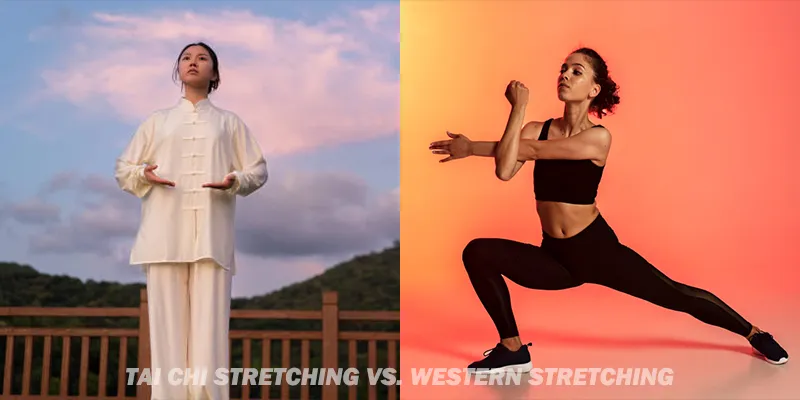
Firstly, western stretching often prioritizes maximizing static flexibility, like touching toes and doing splits. Tai Chi stretching focuses on functional mobility, joint health, tendon resilience, and preparing the body-mind for integrated movement and energy flow.
Secondly, western routines frequently involve isolated, forceful stretches held for static passive or bouncing. Tai Chi stretching exercise favors slow, mindful, dynamic movements or gentle static holds integrated with breath and awareness.
Thirdly, while breath is sometimes coordinated in Western stretching, it is paramount in Tai Chi stretching, used consciously to deepen relaxation, guide movement, and facilitate Qi flow. Mental focus is central.
Finally, western stretchings often target muscles primarily. Tai Chi stretching acknowledges the fascial network and aims for a more integrated “unwinding” and “lengthening” sensation throughout the connective tissue system.
Why Practice Tai Chi Stretching Exercises?
Tai Chi stretching exercises can not only prevent injuries but also make Tai Chi practice safer, more effective, and more in-depth:
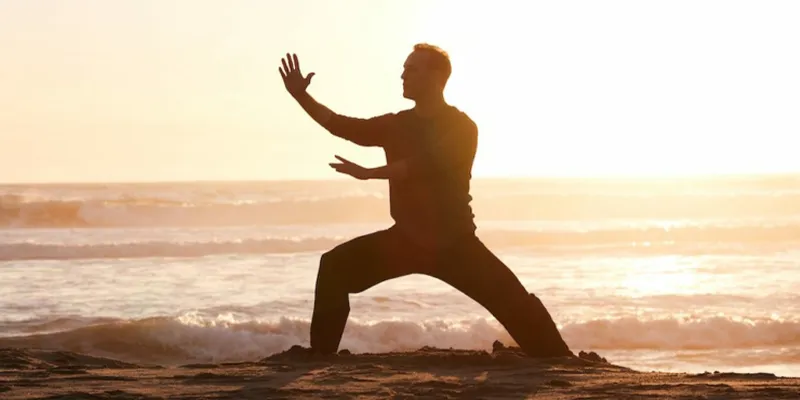
Injury Prevention: Proper tai chi warm-up increases muscle temperature and blood flow, enhancing elasticity. Tai Chi stretches strengthen the tendons and prepare them for various stances and transitions. Mobilizing joints increases synovial fluid production, reducing friction and wear. This preparation reduces the risk of strains, sprains, tendonitis, and joint pain.
Enhanced Exercise Technique: Supple muscles and mobile joints allow for deeper, more stable stances without compromise. Freedom in the hips, shoulders, and spine is essential for the spiraling power central to Tai Chi.
Improved Qi Circulation and Mind-Body Connection: Conscious stretching with breath and intention begins the process of “waking up” the body’s energy pathways. It clears blockages, promotes smooth Qi flow, and establishes the vital connection between mind intent and physical movement.
Increased Body Awareness: Slow, mindful stretching heightens sensitivity to body position, tension levels, and subtle alignments. This awareness is crucial for maintaining correct posture and structure throughout the Tai Chi form.
Mental Preparation and Calm Focus: Tai Chi stretching quiets the mind, reduces stress hormones, and centers attention, preparing the practitioner for a mindful practice session.
Long-Term Joint Health and Mobility: Regular, gentle mobilization and stretching nourish joints, maintain their range of motion, and combat the stiffness that can accompany aging or sedentary lifestyles.
Foundation for Internal Power: True Tai Chi power arises from relaxed, connected, and elastic tissues. Tai chi stretching exercises cultivate suppleness and resilience, allowing force to be generated and transmitted efficiently from the ground up.
Advantages and Disadvantages of Tai Chi Warm-up
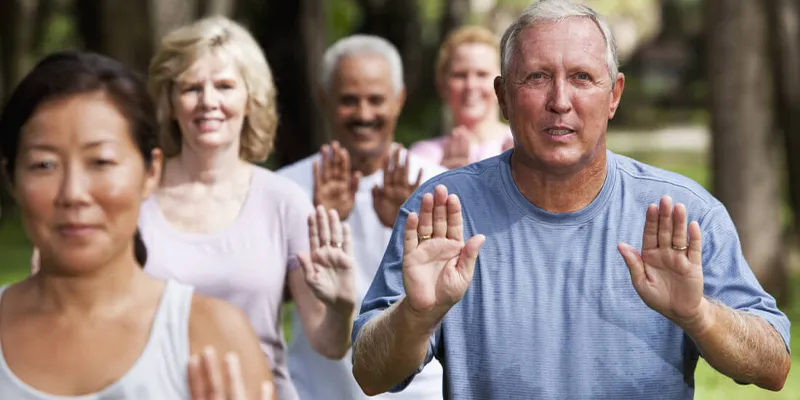
Advantages:
Highly Effective Injury Prevention: Tailored specifically to Tai Chi biomechanics.
Holistic Health Benefits: Improves physical mobility, joint health, circulation, mental focus, and stress reduction simultaneously.
Enhanced Practice Quality: Directly translates to better posture, deeper stances, smoother transitions, and more powerful movement.
Promotes Relaxation & Mindfulness: Starts the practice in a calm, centered state.
Cultivates Qi and Body Sensitivity: A unique benefit integrating energetic and physical aspects.
Accessible and Adaptable: Can be modified for all ages, fitness levels, and physical limitations.
Sustainable Long-Term Practice: A gentle approach minimizes wear and tear, supporting lifelong practice.
Disadvantages:
Requires Patience and Consistency: It’s not a quick fix for extreme flexibility.
Needs Proper Instruction: Incorrect technique (e.g., forcing, poor alignment, ignoring pain) can cause injury.
Time Investment: A thorough warm-up and stretching routine adds 10-20 minutes to practice time.
Not Primarily for Maximum Flexibility: Those seeking extreme exercise may need supplemental Western-style stretching, though Tai Chi provides excellent functional mobility.
Subtlety Misunderstood: The focus on internal sensation and Qi can be difficult for beginners to grasp without guidance.
How to Exercise Tai Chi Stretching Correctly
Mastering Tai Chi stretching exercise is mastering its principles:
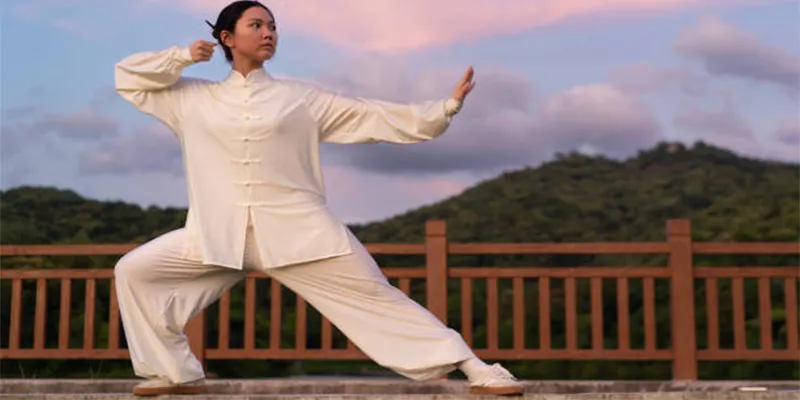
Before moving, set the intention to relax, open, and prepare your body. Inhale naturally to prepare or lengthen the spine. Exhale slowly and completely to deepen the stretch and release tension. Breath guides and facilitates the movement. Never hold your breath.
Move with the fluidity of water. Imagine your limbs moving through a gentle resistance.
Never force; move to the point of a distinct sensation of stretch or release, not pain. Hold dynamic stretches for several breath cycles, allowing the body to gently open further with each exhale.
Engage from the core. Movements often involve the whole body subtly—a wrist stretch connects through the arm to the shoulder and back.
Maintain Tai Chi postural principles even during stretches—head suspended, shoulders sunk, chest slightly concave, lower back relaxed, knees aligned over toes. Protect your joints.
Pain is a signal to stop or ease back. Sensations should be of release and opening, not sharpness or pinching.
Generally, start with gentle joint rotations to increase lubrication. Move to dynamic stretches that gently take muscles and fascia through their range. Include specific stretches for areas heavily used in Tai Chi (hips, hamstrings, groin, calves, shoulders, and spine). Conclude with gentle static holds if used, always with breath and awareness.
Short, regular sessions are far more beneficial than infrequent, long ones. Integrate it into every practice.
Find Tai Chi Stretching Exercise
At Shen Jiangfei International Martial Arts School, we recognize that proper preparation is tai chi’s inseparable foundation.
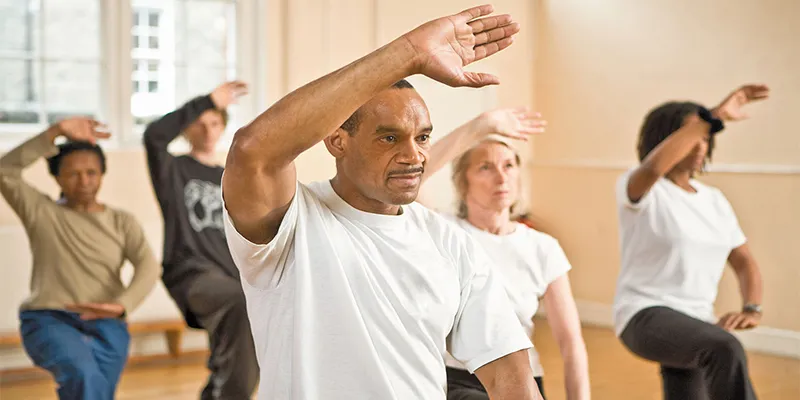
Our senior instructors possess decades of experience not only in Tai Chi Chuan but also in the physiological and energetic principles underpinning effective stretching. We move far beyond generic routines:
Tai Chi-Specific Expertise: Our stretching curriculum is meticulously designed by Tai Chi master Sheng Jiangfei for Tai Chi practitioners. Every exercise directly prepares the body for the unique demands, from Chen style’s explosive power to Yang style’s expansive grace.
Personalized Progression: We understand that everybody is unique. Instructors assess individual flexibility, mobility restrictions, and any prior injuries to tailor stretches and ensure safe, effective progression. You won’t be forced into inappropriate positions.
Holistic Integration: We teach stretching not just as a physical exercise, but as an integral part of cultivating Qi, enhancing body awareness, and developing the mindful focus essential for high-level Tai Chi.
Focus on Safety: Preventing injury is our priority. We teach alignment, breath coordination, and the crucial skill of listening to your body’s signals during tai chi stretching exercises.
Progressive Programs: Whether you are a complete beginner, recovering from an injury, or an advanced practitioner seeking deeper internal connection, our structured programs offer appropriate challenges and support.
International Community: Learn alongside fellow students dedicated to authentic practice in a respectful and encouraging environment.
Conclusion
Tai Chi stretching exercises are far more than a simple warm-up. It prepares your body and mind to receive, express, and cultivate the profound benefits of Tai Chi Chuan. This tai chi stretching exercise prevents the insidious injuries that can derail practice, unlocks greater technical skill and expressive power, enhances vital energy flow, and fosters the deep sense of calm and connection that is the hallmark of true Tai Chi.
Begin every practice by honoring your body with mindful Tai Chi stretching, and experience the transformative difference it makes on your journey towards health, vitality, and mastery.
Visit Shen Jiangfei International Martial Arts School today and let our masters guide you in mastering the essential art of Tai Chi stretching.

